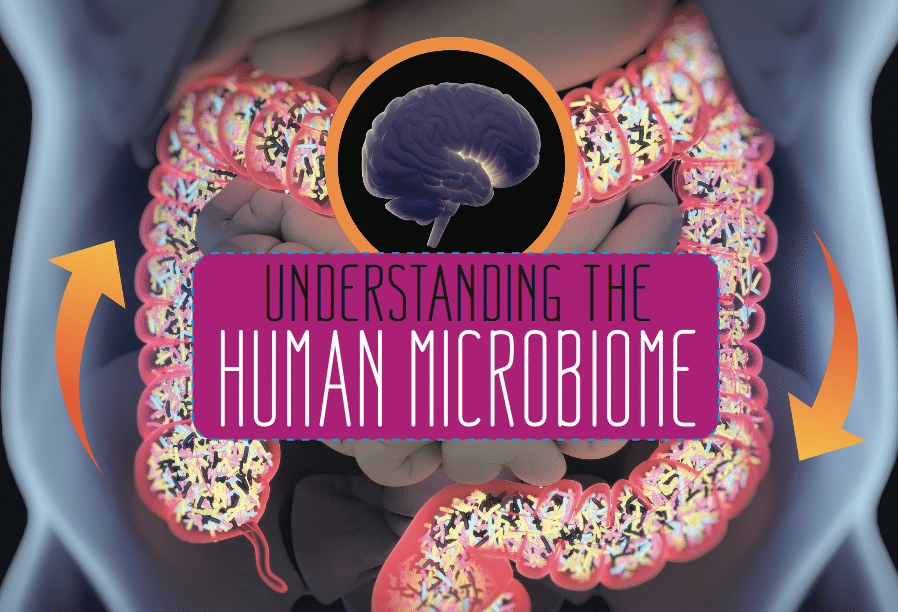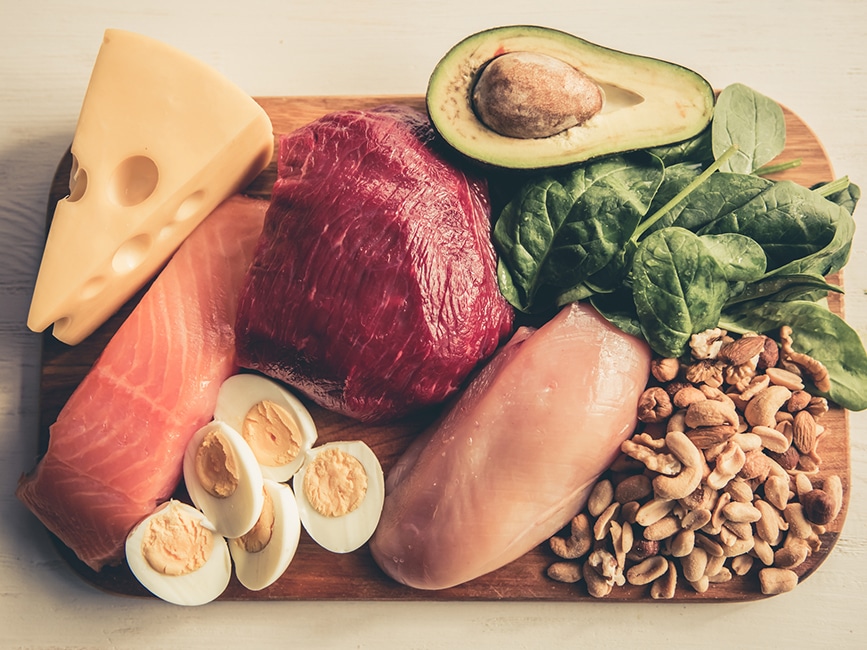Understanding the Human Microbiome
Trillions of bacteria, viruses and other microbes dwell within our bodies, affecting our health and overall well-being. Here's a look at how they interact.

Humans are never alone. Each of us co-exists with trillions of microscopic organisms that form the human microbiome, a complex web of life that’s analogous to earthly biomes such as deserts, tundra and rainforests.
The microbiome extends from deep within our bodies—even inside individual cells—to the skin and to all surfaces exposed to the external environment. It includes bacteria, viruses, yeasts and fungi that interact with the body’s systems, helping with digestion, immune response and a vast array of less-well-known bodily functions.
Our microbiomes vary widely depending on stage of life (from infancy to advanced age), birth route (vaginal or by cesarean section), and whether we were breastfed or formula-fed. Travel, diet, illness, medication, environmental exposure, climate, water and many other variables also shape the human microbiome. Indeed, each human’s microbiome is thought to be as unique as a fingerprint.
In the past few years, news reports, magazine articles and scholarly research have documented the microbiome’s profound influence on our health and well-being. Since nutrition and exercise are among the factors that can affect the microbiome, health and fitness professionals need to understand the microbiome fundamentals in relation to genes, cells, various bodily systems and, especially, the gut and digestive tract.
Pathways From the Second Brain
The microbes in our digestive tract play a central role in human health, helping to break down foods and distribute nutrients. In the gut, the microbiome communicates with the rest of the body via pathways in the enteric nervous system, a neural web so sophisticated that it’s often called the second brain. The enteric nervous system has over 500 million neurons and more than 40 distinct neurotransmitters. In fact, the major neurotransmitters of the body are primarily in the enteric nervous system and the gastrointestinal tract. Approximately 95% of the serotonin and 50% of the dopamine in humans are in the enteric nervous system.
The prominent vagus nerve, also known as the 10th cranial nerve, is a direct communication pathway between the gut, the brain and other vital organs. Over 80% of the nerve fibers in the vagus nerve are arranged to deliver information and instructions from the gut to the brain, not the other way around.
The nerves connecting the central and enteric nervous systems are an obvious pathway for communication between the two. But there are other pathways linking the brain, gut, microbiome, diet and external environment. These include the immune system, with chemical cytokines (secreted proteins) acting as messengers; the endocrine system, with hormones, neurotransmitters and metabolites; and the direct absorption and transfer of microbes, metabolites, toxins and environmental agents.
Many of the metabolites, neurotransmitters, cytokines and hormones in a human body are generated by microbes in the gut microbiome. Thus, a lot of experts consider the gut microbiome another human organ system, even though it primarily consists of about 3–5 pounds of nonhuman life forms.
Human Microbiome and The Gut Influence
The gastrointestinal tract and the enteric nervous system are a rich source of hormones that perform critical functions. Among these hormones, the best-known are insulin and glucagon, which control blood sugar homeostasis. Many other hormones play significant roles in metabolism, gut physiology, appetite, fat deposition and weight control.
The gut microbiome exerts some of its powerful influence via the production, release and manipulation of hormones. Manipulating enteroendocrine cells that produce gut hormones such as ghrelin and leptin to help manage obesity is an area of great research interest.
The enteric nervous system, neurotransmitters and gut hormones are intimately involved with the gut immune system, microbiome and diet. The gut is both an internal and an external organ, serving as the primary exposure of the internal body to the external environment. The gastrointestinal tract is a long tunnel that connects the external environment to the internal confines of the body. Material in the gastrointestinal tract is considered external to the body until the lining cells absorb it or it breaches the tight junctions between cells (described as a “leaky gut”).
The surface area of the gut is the largest in the body, roughly the size of a championship doubles tennis court. As the body’s primary interface with the external environment, the gut is where more than 90% of immune system activity takes place.
Diet and the Human Microbiome
Diet appears to play a critical role in the balance and composition of the gut microbiome, offering opportunities to develop alternative prevention and treatment strategies for microbiome-associated disorders. Finding definitive answers is challenging because we do not know what mix of species and populations is best for maintaining optimal health and avoiding disease. Each person’s balance differs because of genomics, epigenetics, immunities, previous illnesses, activity levels, medications and many more variables.
Advances in genetic sequencing raise the possibility of implementing personalized medicine based on diet, microbiome and health-enhancing activities. The U.S. Food and Drug Administration recently allowed the commercial application of genomic testing for predisposition to specific concerns, such as cancer. In all likelihood, this will rapidly expand to a wide variety of health concerns, including weight management, diet, fitness, depression and others—all factors the microbiome can influence.
A blood test known as the postprandial glucose response (PPGR) provides a risk factor indicator for obesity and diabetes. Recent research confirms that the gut microbiome can play a major role in PPGR, weight control and individual response to a specific diet. With dietary manipulation, PPRG can drop significantly, and analysis of the gut microbiome is beginning to allow tailored dietary advice, though the role of individual organisms within the microbiome is not yet fully understood (Zeevi et al. 2015).
See also: Food Additives and Our Microbiome
Human Microbiome and Weight Loss
Studies have shown that environmental epigenetic influences can dominate genetic factors in shaping the gut microbiome (Rothschild et al. 2018).
Recent studies also underscore the microbiome’s critical role in the body’s ability to extract calories and specific nutrients from the diet for effective use. How much food is eaten, when, and in what sequence and combinations may play a role as well.
The gut microbiome can change rapidly, and dietary intake, pharmaceuticals, antibiotics, probiotics and many other environmental factors may have a significant influence on it. As it changes, so does the ability to digest, absorb and utilize nutrients.
Weight affects overall health, as does body composition, especially percent of body fat. (Some recent studies suggest that fitness and fatness may be relatively independent health risk factors [Kennedy, Lavie & Blair 2018].) The gut microbiome’s link to weight loss has become appreciated only relatively recently. Microbes in the gut ferment and digest normally digestible material, where they accelerate the process, as well as normally nondigestible material. Microbes convert the latter into digestible fragments, which now represent absorbable calories.
Different species of microbes have unique properties, and a change in the microbiome can have a profound effect on the calories extracted from any product and their absorption. The gut microbiome also consumes some of the nutrients released, using them for its own metabolism and thus preventing their absorption by the human host. A microbiome with overly efficient calorie extractors can contribute to obesity. Less efficient or inefficient microbes, which leave calories in the substrate unavailable to human digestion, can contribute to weight control or weight loss. Some important nutrients in the diet are entirely dependent on microbial metabolism, one example being vitamin K, which is critically important to blood clotting.
See also: How Does Diet Affect the Human Microbiome?
Demographics of the Gut
The general proportions of various microbial populations in the overall mix have also been associated with differences in age, diet and disease. Microbes colonize the gut and promote child growth by synthesizing vitamins, facilitating immune and enteric nervous system development, and enhancing energy extraction from the diet.
The composition and functions of gut microbiota change dramatically across a lifespan. At birth, the microbiome consists of vaginal and fecal microbes in those born vaginally, and skin flora in those born by Cesarean section. It takes about 2 years for the newborn gut microbiome to transition to a more adultlike population diversity. Which type of inoculation a baby receives through birth can have lifelong consequences, with vaginal flora associated with greater health and vitality. Researchers are working on identifying gut microbiome changes associated with optimal nutrition, growth and development in children (Subramanian et al. 2015).
Communicating With the Nervous System
Gut bacteria can communicate with the neural system via multiple pathways, including direct interaction with the immune system. Bacteria can affect serotonin production in colonic enterochromaffin cells (the most common type of neuroendocrine cell); modulate levels of endogenous catecholamines in the gut lumen (the gut’s interior space); and produce gamma-aminobutyric acid (GABA) and other neuroactive molecules, including short-chain fatty acids (SCFAs).
The gut microbiome has often been altered in patients with chronic GI diseases and neuropsychiatric disorders. Administering specific probiotics can alter brain connectivity in healthy individuals and improve depression scores and neural activity associated with mood control.
Helping With Immunities
Studies also support the concept of mechanisms linking food to microbial metabolites that in turn can influence diseases and immune response (Postler & Ghosh 2017). In ardiovascular disease, high choline-containing foods (eggs, beef liver, pork, fish, etc.) have been associated with increased cardio-vascular disease risk through a bacterial
metabolite called trimethylamine-N-oxide. Meanwhile, cruciferous vegetables such as kale, broccoli and cauliflower have been associated with decreases in cancer risk through metabolism of glucosinolates by intestinal bacteria.
Indeed, diet-microbiome interactions have been implicated in a wide variety of diseases and health issues. The microbes may produce influential metabolites from dietary components or from components produced by the human host, or they may be synthesized entirely from the microbes themselves.
Prebiotics and Synbiotics
A prebiotic is defined as “a non-digestible compound that, through its metabolization by microorganisms in the gut, modulates composition and/or activity of the gut microbiota, thus conferring a beneficial physiological effect on the host” (Bindels et al. 2015). Prebiotics now go beyond traditional oligosaccharides (fructo- and galacto-oligosaccharides and inulin) to include noncarbohydrates and more complex carbohydrates.
There is also a growing interest in synbiotics, which combine prebiotics and probiotics. As specific microbes are studied, precise recommendations for probiotics, prebiotics and synbiotics will become safe and cost-effective.
Dynamic Research
Rapid advances in our understanding of the gut microbiome are overturning many previously held beliefs. The gut microbiome appears to have a greater influence on the postprandial glucose response to certain foods than an individual’s own genomics (Zeevi et al. 2015). The impact of the gut microbiome on drug metabolism, with its influence on clinical outcomes, is now being explored (Enright et al. 2016). The belief that the womb and fetus are sterile until birth has been disproven, as both are seeded with microbes before birth (Walker et al. 2017). In fact, many organs, including the brain, frequently harbor microbes, a significant number of which reside not just between human cells but within these cells.
Exercise has been found to be an important influence on, and determinant of, the gut microbiome (Allen et al. 2017; Barton et al. 2018; Cerda et al. 2016). The health benefits may be due to the effects of exercise on the microbiome through changes in metabolism, immune function or intestinal transit time.
Antibiotics, probiotics, prebiotics, sleep, exercise, colonics, diet, food-combining and other lifestyle changes may influence the gut microbiome to an extent not previously recognized (Allen et al. 2017; Meng et al. 2017; Singh et al. 2017; Estaki et al. 2016; Smits et al. 2017). Exercise equipment, gyms and the buildings where people live and work are being re-evaluated as influencers of the microbiome (Wood et al. 2015; Adams et al. 2016).
Identifying microbes and their role in the manufacture of specific neurotransmitters is bringing us closer to the advent of psychobiotics designed to influence mood and behavior (Sarkar et al. 2016). For antibiotic-associated colitis, the current treatment of choice is a fecal transplant of a healthy microbiome. As the microbiomes of fit, lean and healthy individuals are identified as a potential source of their health and wellness, envy of the quality of their residue will bring a whole new level of attention to fecal transplants.
A Boon From the Microbiome
What was once heresy may become therapy. Exploration of the microbiome is leading to revolutionary changes in health, wellness and disease management. Research which revealed that healthy low-fat diets could be as effective for weight loss as healthy low-carb diets in motivated individuals, and that no specific genetic or insulin factor was key, is being re-explored for the effects of the microbiome and epigenetics. Meanwhile, the take-home message is to eat less sugar, less refined flour, more whole foods and as many vegetables as possible (Gardner et al. 2018). Research and technological advances are occurring with breathtaking rapidity, ushering in an exciting new era of precision health, wellness and fitness (Kuntz & Gilbert 2017; Sonnenburg & Backhed 2016).
A QUICK HISTORY OF THE MICROBIOME
Understanding the microbiome starts with understanding the genes of the gut microbes. In the world of genetics, DNA (deoxyribonucleic acid) and RNA (ribonucleic acid) represent the universal language of life on Earth. The four nucleic acid bases in DNA (guanine, cytosine, thymine and adenine) and the fifth nucleic acid base of RNA (uracil, which replaces thymine) have roots in the first life forms on Earth, which were most likely precellular or unicellular organisms like bacteria or archaea.
Over the billions of years of prehistory, these early life forms changed the environment and atmosphere of the planet by releasing oxygen as a waste product of photosynthesis. Evolution favored organisms that could survive and thrive in the new atmosphere and surface of a planet in transition. As genes mutated, subsequent generations developed new properties and differentiated into a growing diversity of species.
The most recent estimate suggests that between 100 billion and 1 trillion microbial species inhabit our planet. The metabolic processes of all of these organisms and species give rise to trillions of unique metabolites, each of which may have consequences for the planet’s environment and for human health and wellness.
PERVASIVE MICROBES
The gut microbiome of modern humans hosts more than 100 trillion microorganisms, representing tens of thousands, if not millions, of species. Although a single species of microbe can cause a devastating human disease, most microbes are either commensals, which don’t cause harm or disease, or symbionts, which benefit both the microbe and its host.
Bacteria and archaea make up the predominant biomass on Earth. Only a small minority of them have been identified, and the majority cannot be grown or cultured. They are so pervasive that a gram of soil has an average of 40 million bacteria and a milliliter of seawater (one-fifth of a teaspoon) has over 1 million bacteria. Over billions of years, species have evolved along widely divergent pathways, yet some key genetic features remain unchanged. Our closest relatives, the chimpanzee and bonobo, share 98.4% of human DNA, but our most distant relatives—unicellular bacteria and archaea—still have a 30% genetic overlap with humans.
Because of the preservation of genes throughout evolution, the universal genetic language allows back-and-forth influence between widely divergent species. This principle explains how millions of genes in the microbiome, diet and environment influence the roughly 20,000 human genes. When humans encounter genes from a food source (plant, animal or fungi) or the environment, the body understands the gene’s message because it is written in the universal language. Thus, the gene’s activation can change the cells and behavior of the entire organism.
NEW RESEARCH AVENUES
Advancements in molecular techniques combined with falling costs for DNA and RNA sequencing have made shotgun metagenomics, transcriptomics, metabolomics and proteomics (defined in the sidebar “Genetics Vocabulary”) valuable tools for research. These types of analysis can use multiple genes to assess and identify organisms in the microbiome.
Using mass spectrometry to identify the presence of small molecules derived from the host, environment or microbiome can also add critical information, such as drug-microbe interactions specific to unique body sites.
A recent publication reported that this technology has identified large quantities of microbial metabolites circulating in human blood that have never been seen before (Kowarsky et al. 2017). The development of metabolomics libraries has enlarged the database of known metabolites. This information allows for identification of previously unrecognized organisms in the gut microbiome. Similar technological advances have been used to identify tumor markers, and the advent of blood tests for the early diagnosis of cancer is on the horizon.
GENETICS VOCABULARY
- Epigenetics. The study of heritable changes in gene function that do not involve changes in the gene sequence. Environmental factors typically cause these changes.
- Genomics. The science of structure, function, evolution, mapping and editing of genomes.
- Metabolomics. The study of the unique chemicals and products of metabolism, used to indirectly identify the presence of specific organisms.
- Proteomics. The study of the proteins produced in a cell, organ or organism and their functions. The proteome can differ from one cell to another in the same tissue, organ or organism and can also change with time and life cycle.
- Transcriptomics. The study of the transcriptome, the full set of RNA, including messenger RNA (mRNA), transfer RNA (tRNA), ribosomal RNA (rRNA) and other noncoding RNA.
References
Adams, R.I., et al. 2016. Ten questions concerning the microbiomes of buildings. Building and Environment, 109 (15), 224–34.
Allen, J.M., et al. 2017. Exercise alters gut microbiota composition and function in lean and obese humans. Medicine & Science in Sports & Exercise, 50 (4), 747–57.
Barton, W., et al. 2018. The microbiome of professional athletes differs from that of more sedentary subjects in composition and particularly at the functional metabolic level. Gut, 67 (4), 625–33.
Bindels, L.B., et al. 2015. Towards a more comprehensive concept for prebiotics. Nature Reviews Gastroenterology & Hepatology, 12 (5), 303–10.
Cerda, B., et al. 2016. Gut microbiota modification: Another piece in the puzzle of the benefits of physical exercise in health? Frontiers in Physiology, 7, 51.
Enright, E.F., et al. 2016. The impact of the gut microbiota on drug metabolism and clinical outcome. Yale Journal of Biology and Medicine, 89 (3), 375–82.
Estaki, M., et al. 2016. Cardiorespiratory fitness as a predictor of intestinal microbial diversity and distinct metagenomics functions. Microbiome, 4 (42).
Gardner, C.D., et al. 2018. Effect of low-fat vs low-carbohydrate diet on 12-month weight loss in overweight adults and the association with genotype patter or insulin secretion: The DIETFITS Randomized Clinical Trial. JAMA, 319 (7), 667–79.
Hill, C., et al. 2014. Expert consensus document: The International Scientific Association for Probiotics and Prebiotics consensus statement on the scope and appropriate use of the term probiotic. Nature Reviews Gastroenterology & Hepatology, 11 (8), 506–14.
Kennedy, A.B., Lavie, C.J., & Blair, S.N. 2018. Fitness or fatness: Which is more important? JAMA, 319 (3), 231–32.
Kowarsky, M., et al. 2017. Numerous uncharacterized and highly divergent microbes which colonize humans revealed by circulating cell-free DNA. Proceedings of the National Academy of Science, 114 (36), 9623–28.
Kuntz, T.M., & Gilbert, J.A. 2017. Introducing the microbiome into precision medicine. Trends in Pharmacological Sciences 38 (1), 81–91.
Meng, H., et al. 2017. Effect of prior meal macronutrient composition on postprandial glycemic responses and glycemic index and glycemic load value determinations. American Journal of Clinical Nutrition, 106 (5), 1246–56.
Postler, T.S., & Ghosh, S. 2017. Understanding the holobiont: How microbial metabolites affect human health and shape the immune system. Cell Metabolism, 26 (1), 110–30.
Rothschild, D., et al. 2018. Environment dominates over host genetics in shaping human gut microbiota. Nature, 555 (7695), 210–15.
Sarkar, A., et al. 2016. Psychobiotics and the manipulation of bacteria-gut-brain signals. Trends in Neuroscience, 39 (11), 763–81.
Singh, R.K., et al. 2017. Influence of diet on the gut microbiome and implications for human health. Journal of Transitional Medicine, 15 (1), 73.
Smits, S.A., et al. 2017. Seasonal cycling in the gut microbiome of the Hadza hunter-gatherers of Tanzania. Science, 357 (6353), 802–6.
Sonnenburg, J.L., & Backhed, F. 2016. Diet-microbiota interactions as moderators of human metabolism. Nature, 535 (7610), 56–64.
Subramanian, S., et al. 2015. Cultivating healthy growth and nutrition through the gut microbiota. Cell, 161 (1), 36–48.
Walker, R.W., et al. 2017. The prenatal gut microbiome: Are we colonized with bacteria in utero? Pediatric Obesity, 12 (1), 3–17.
Wood, M., et al. 2015. Athletic equipment microbiota are shaped by interactions with human skin Microbiome, 3 (25).
Zeevi, D., et al. 2015. Personalized nutrition by prediction of glycemic responses. Cell, 163 (5), 1079–94.
Joe Weiss, MD
Joseph B. Weiss, M.D. is Clinical Professor of Medicine in the Division of Gastroenterology, Department of Medicine, at the University of California, San Diego. Accepted to university at age fifteen he attended the University of Michigan, University of Detroit, and Wayne State University. Reflecting his broad interests, he majored in Medieval English Literature, Astrophysics, and Invertebrate Zoology. Following his graduation from the Wayne State University School of Medicine in Detroit, Michigan, he completed his internship and residency in Internal Medicine at the University of California, Irvine Medical Center in Orange, California. Under the auspices of the World Health Organization and others, he has pursued interests in Tropical and International Medicine and Public Health with extended stays in Africa, the Middle East, and Latin America. Subsequently completing a clinical and research fellowship in Gastroenterology at the University of California, San Diego, he has remained active on the clinical facul






